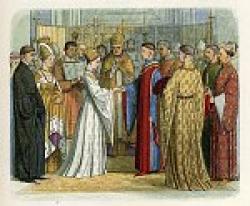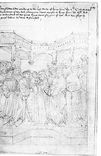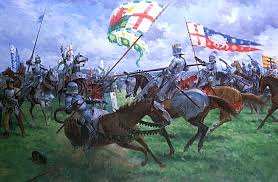His death left his nine-month-old son, Henry King of England and within a year the boy would be king of France
|
It was on this day in 1420 that the Treaty of Troyes was ratified. King Henry V had worked hard to bring the French to the negotiation table, he quickly followed this by marrying Catherine of Valois, the daughter of Charles VI of France and the sister of the Dauphin. With the treaty signed Henry V was declared heir and regent to the Charles VI of France, this meant that on Charles's death France and England would be ruled by one king. However, things did not go as expected, in the December of 1421, the hero of Agincourt lay dying from dysentery at the Chateau de Vincennes in France.
His death left his nine-month-old son, Henry King of England and within a year the boy would be king of France
0 Comments
Catherine of Valois, the youngest daughter of King Charles VI of France and King Henry V, the eldest son of Henry IV were married in the June of 1420. Eighteen months later, on the 6th of December 1421 St Nicholas's Day, Catherine gave birth to Henry of Windsor, a second joyous event of 1421 that had followed her coronation in Westminster Abbey the previous February. Henry's arrival in the world was assisted by the presence of 'Our Lords foreskin' a relic known as the Silver Jewel that was brought over from France in time for his birth at Windsor Castle. The heir to the throne was born while his father was in France besieging the town of Meaux and it was there that Henry V heard of the arrival of his son. A story originating from the Tudor period suggests that Henry considered having his son born at Windsor was a bad omen, and indeed it seems that he was right to be concerned, for the hero of Agincourt was dead at the age of 36 the following August. Henry V's death from dysentery left his baby son to succeed to the English throne at just nine months old, the poor child would inherit the French throne on the death of his maternal grandfather Charles VI only two months later. Henry V's last will and testament was thought lost but it turned up in 1978 at Eton College. In this document Henry had instructed that his younger brother Humphrey of Gloucester should be the baby's principal guardian and his uncle Thomas Beaufort was to have governance of the 'child's person.' Henry other brother, John, Duke of Bedford was instructed by Henry on his deathbed with the charge of the new kings French domain, however as history tells us there would be trouble ahead! Henry, as we all know, turned out to be a shy, quiet and passive boy who disliked warfare and violence and who eventually succumbed to mental illness the poor soul would be completely unaware of all that was going on around him, he would be unable to stand, walk or move without help and in 1454 when he was presented with his newborn son all he managed was to raise and lower his eyes. Henry VI was not suited for kingship and it has been suggested that he was not suited for marriage either. I think that he was just not a match for a strong and aggressive woman as his queen Margaret of Anjou most certainly was, we can only wonder what would have happened if he had been matched with a less fiery mate, one who was more in tune with him and prepared to listen to reason. But as we known that was not the case. King Henry VI's first reign over England lasted from 1422 until 1461 and his second, after his restoration, from 1470 to 1471. Henry VI's time as monarch saw an England under a weak rule and this would bring about the period known as the Wars of the Roses and from mothers liaison, with the son of a Welsh publican, the mighty Tudor dynasty would spring.
Henry Percy, first Earl of Northumberland was, according to Shakespeare: "the ladder upon which the mounting Bolingbroke ascends the throne.” This statement reflects the rise of the Percy family during the reign of Richard II and the subsequent usurpation of the throne by Henry Bolingbroke. Henry Percy was born on the 10th November 1341/2. The first two decades of Percy's life were unremarkable, however the twenty years following his father's death lead Percy to great heights of power and influence, not only in his own stamping ground but in the country as a whole. Henry Percy headed a family that included his sons Henry 'Hotspur' and Thomas, all three were guardians of the English boarder with Scotland. As Lords of the North, and as the previous statement states, they were involved in the future Henry IV taking the crown of England. However, siding with Henry had its problems, and the Percy's would soon regret helping Bolingbroke take his seat on the throne of England. We cannot think of the Percy family without considering the part they played in the Wars of the Roses. Many believe that the First Battle of St Albans, in 1455, was as much about the ongoing squabble between the Percy's and their nemesis the Neville's, as it was about the wider squabble, that of the House of York and Lancaster. It cannot be doubted that this battle, for the individual members of these two northern families, was very personal, each trying to destroy the other under the guise of a greater cause. The origins of Percy/Neville squabble had it roots in land, or the loss of it, bitterness turned to anger, discussion to litigation, skirmishes into outright warfare that initiated the 'the beginning of the greatest sorrows in England." Henry Percy died a traitor at Bramham Moor, the last battle of the Percy's rebellion, on the 19 February 1408 and as was the norm for a traitor, his head was decapitated and sent to London, placed for all to see on London Bridge, it was reunited with his quartered remains and eventually buried in York Minster.
The most famous image of Henry V is held by the National Portrait Gallery, it is a 16th century copy, in it Henry looks as if he is at prayer. His hair is cut very short around the ears and at the back which was the style of the time. It is thought that he was painted this way deliberately to hide the right side of his face on which he is said to have a nasty arrow wound received at the Battle of Shrewsbury on the 21st July 1403. Matthew Ryan, in his text to accompany his images below states: "The shaft of the arrow was removed but the bodkin remained, left embedded into his skull to a depth of around six inches. This was later removed at Kenilworth Castle by some ingenious work of the surgeon John Bradmore who later went on to write a detailed account of the procedure." You can see Matthew's album on this on his Facebook page here
www.facebook.com/matthewryanhistoricalillustrator/media_set?set=a.842095342540698.1073741879.100002207204372&type=3 and more of his great art work on his website matthewryanhistoricalillustrator.com/ You can read more about Henry here meanderingthroughtime.weebly.com/wars-of-the-roses-blog/king-henry-v My knowledge of Henry's life and times has grown slowly over the years, I know more now than I did when I first wrote this blog when my historical interest lead me away from this era via the family feuds of the Percy's and the Neville's to the dynastic battles we know as the Wars of the Roses. The first thing that springs to mind when I think of Henry V is his appearance. In the most famous image of him, which is held by the National Portrait Gallery, his hair is cut very short around the ears and at the back which was the style of the time. It is thought that he was painted this way deliberately to hide the right side of his face on which he is said to have a nasty arrow wound which he received in battle.
The portrait is a 16th century copy, in it Henry looks as if he is at prayer. He, of course, was regarded as the hero of the nation due to his victory over the French at Agincourt, the battle which saw the English longbow come to the forefront, but also the place where he ordered the deaths of several thousand French prisoners. The date of Henry's birth is said to be either the 9th or the 16th of August in 1386/7, he was born the second son of Henry IV, he had, by the age of seventeen taken part in the Battle of Shrewsbury and topped that with five years fighting against Welsh and the legendary Owen Glendower, the last Welsh leader to be known as the Prince of Wales. Henry also put down a rebellion lead by Richard of Conisburgh grandfather to Richard III, Henry Scrope and Thomas Grey and their attempt to put Edmund Mortimer on the English throne. This later became known as the Southampton Plot. We also remember King Henry V for his involvement with France where between 1415 and 1420 he was successful in taking the port of Harfleur, the town of Rouen, and managed to force the French to sign the Treaty of Troyes. Following his success in France, Henry was recognised as the heir to the French throne which was sealed by his marriage to Charles VI's daughter Catherine of Valois. The couple returned home to England, six months later Catherine was crowned queen and two months later, Henry returned to France. The young queen gave birth to her son Henry, later Henry VI, in the December of 1421, but the of hero of Agincourt lay dying from dysentery at the Chateau de Vincennes, in France, where he died on the 31st of August, leaving his lands and titles in the tiny hands of his nine month old son. If King Henry V had not died that summers day in France, Catherine of Valois would not have been left a young widow to find solace in the arms of Owen Tudor and therefore no there would have been no Henry VII and no Tudor dynasty. There are two interesting articles on Henry V's achievements one from 1986 by Nigel Saul entitled Henry and the Duel Monarchy and another by Dan Jones entitled From Agincourt to Bosworth, both can be read here. www.historytoday.com/nigel-saul/henry-v-and-dual-monarchy www.historytoday.com/dan-jones/agincourt-bosworth This is a question with no easy answer, but it can be looked at in a number of ways. If we consider the Wars of the Roses began in 1455 with the first battle of St Albans we should look at the Battle of Tewkesbury as the final battle in these wars. The origins of these battles had their roots in the rivalry between the Duke of Somerset and the Duke of York. Following King Henry VI 'regaining his senses' Edmund Beaufort was given back his former post. To make matters worse, Beaufort was also given the captaincy of Calais which really rubbed York up the wrong way, eventually, it came to blows at St Albans. You could say that the following fifteen battles, not including Bosworth and Stoke, were just a continuation of this, although there was far more to it than that. The beginning of the end was the death of Henry VI's son Edward at Tewkesbury, followed seventeen days later by Henry himself. You could that say the Wars of the Roses did indeed end at Tewkesbury. On the other hand, if you consider, like I do, the Wars of the Roses began or at least the seeds were set on the 8th June 1376 with the death of Edward III's heir Edward the Black Prince. The fallout from the Black Prince's death cannot be underestimated. A boy king, an influential and 'lustful' uncle, an illegitimate brood and a usurper, lead you to follow two lines. Firstly that of the usurper, where you end up at Henry VI and Margaret Beaufort/Henry Tudor and secondly, if you follow the line of John Beaufort, Gaunt's illegitimate son, you get Margaret Beaufort and Henry Tudor. Which line you follow makes no difference you will end up with events of 1483 to 1485. With all that in mind, you will have to say that the Wars of the Roses ended at Bosworth. Two years after Bosworth the armies of York and Lancaster met again at Stoke Field in Nottinghamshire. Henry VII found himself in the same position as that of Richard III defending his crown and facing a rebel army who were intent on placing a Plantagenet on the throne, albeit an impostor. Lambert Simnel, a claimant to England's throne posing as Edward, Earl of Warwick, was crowned in Dublin by John de la Pole and Francis Lovell. With a Plantagenet claimant as their figurehead, only Henry VII stood in their way. John de la Pole died on the battlefield, Lovell's body was not among the dead, but his days were numbered. This battle effectively wiped out the last of the Yorkist rebels, enabling Henry VII to establish the Tudor dynasty virtually unchallenged, on the battlefield at least. Did the Wars of the Roses end with the Lancastrian victory at Stoke Field? What is the answer then Tewkesbury, Bosworth or Stoke? |
Categories
All
Archives
May 2024
|





















 RSS Feed
RSS Feed
